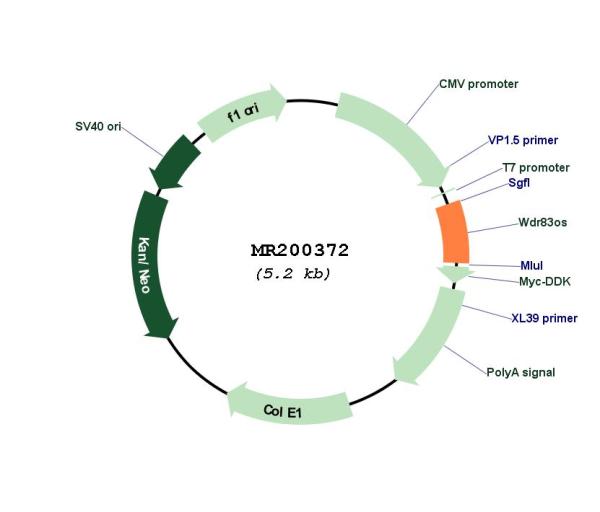Wdr83os (NM_001001493) Mouse Tagged ORF Clone
CAT#: MR200372
- TrueORF®
BC056474 (Myc-DDK-tagged) - Mouse cDNA sequence BC056474 (BC056474)
ORF Plasmid: tGFP
Lentiviral Particles: DDK w/ Puro mGFP w/ Puro
AAV Particle: DDK
"NM_001001493" in other vectors (4)
Interest in protein/lysate? Submit request here!
USD 198.00
Specifications
| Product Data | |
| Type | Mouse Tagged ORF Clone |
| Tag | Myc-DDK |
| Symbol | Wdr83os |
| Synonyms | Wdr83os |
| Vector | pCMV6-Entry |
| E. coli Selection | Kanamycin (25 ug/mL) |
| Mammalian Cell Selection | Neomycin |
| Sequence Data |
>MR200372 ORF sequence
Red=Cloning site Blue=ORF Green=Tags(s) TTTTGTAATACGACTCACTATAGGGCGGCCGGGAATTCGTCGACTGGATCCGGTACCGAGGAGATCTGCC GCCGCGATCGCC ATGTCCACTAACAATATGTCCGACCCACGAAGGCCCAACAAAGTGCTGAGGTATAAGCCTCCCCCGAGTG AGTGCAACCCGGCTTTAGACGACCCGACTCCGGACTACATGAATCTTCTTGGCATGATCTTCAGCATGTG TGGCCTCATGCTTAAGCTGAAGTGGTGTGCTTGGGTTGCTGTCTACTGCTCCTTTATCAGCTTTGCCAAC TCGCGGAGCTCGGAGGACACTAAGCAGATGATGAGTAGCTTCATGCTCTCTATCTCCGCCGTGGTGATGT CCTATCTGCAGAATCCTCAGCCCATGACGCCTCCCTGG ACGCGTACGCGGCCGCTCGAGCAGAAACTCATCTCAGAAGAGGATCTGGCAGCAAATGATATCCTGGATT ACAAGGATGACGACGATAAGGTTTAA >MR200372 protein sequence
Red=Cloning site Green=Tags(s) MSTNNMSDPRRPNKVLRYKPPPSECNPALDDPTPDYMNLLGMIFSMCGLMLKLKWCAWVAVYCSFISFAN SRSSEDTKQMMSSFMLSISAVVMSYLQNPQPMTPPW TRTRPLEQKLISEEDLAANDILDYKDDDDKV |
| Restriction Sites |
SgfI-MluI
Cloning Scheme for this gene
Plasmid Map

|
| ACCN | NM_001001493 |
| ORF Size | 321 bp |
| OTI Disclaimer | The molecular sequence of this clone aligns with the gene accession number as a point of reference only. However, individual transcript sequences of the same gene can differ through naturally occurring variations (e.g. polymorphisms), each with its own valid existence. This clone is substantially in agreement with the reference, but a complete review of all prevailing variants is recommended prior to use. More info |
| OTI Annotation | This clone was engineered to express the complete ORF with an expression tag. Expression varies depending on the nature of the gene. |
| Product Components | The ORF clone is ion-exchange column purified and shipped in a 2D barcoded Matrix tube containing 10ug of transfection-ready, dried plasmid DNA (reconstitute with 100 ul of water). |
| Reconstitution | 1. Centrifuge at 5,000xg for 5min. 2. Carefully open the tube and add 100ul of sterile water to dissolve the DNA. 3. Close the tube and incubate for 10 minutes at room temperature. 4. Briefly vortex the tube and then do a quick spin (less than 5000xg) to concentrate the liquid at the bottom. 5. Store the suspended plasmid at -20°C. The DNA is stable for at least one year from date of shipping when stored at -20°C. |
| Reference Data | |
| RefSeq | NM_001001493.2, NP_001001493.1 |
| RefSeq Size | 815 bp |
| RefSeq ORF | 321 bp |
| Locus ID | 414077 |
| UniProt ID | Q6ZWX0 |
| Cytogenetics | 8 C3 |
| MW | 12.1 kDa |
| Gene Summary | Component of the PAT complex, an endoplasmic reticulum (ER)-resident membrane multiprotein complex that facilitates multi-pass membrane proteins insertion into membranes. The PAT complex acts as an intramembrane chaperone by directly interacting with nascent transmembrane domains (TMDs), releasing its substrates upon correct folding, and is needed for optimal biogenesis of multi-pass membrane proteins. WDR83OS/Asterix is the substrate-interacting subunit of the PAT complex, whereas CCDC47 is required to maintain the stability of WDR83OS/Asterix. WDR83OS/Asterix associates with the first transmembrane domain (TMD1) of the nascent chain, independently of the N-glycosylation of the chain and irrespective of the amino acid sequence and transmembrane topology of TMD1. The PAT complex favors the binding to TMDs with exposed hydrophilic amino acids within the lipid bilayer and provides a membrane-embedded partially hydrophilic environment in which TMD1 binds.[UniProtKB/Swiss-Prot Function] |
Documents
| Product Manuals |
| FAQs |
| SDS |
Resources
Other Versions
| SKU | Description | Size | Price |
|---|---|---|---|
| MC207977 | BC056474 (untagged) - Mouse cDNA sequence BC056474 (BC056474), (10ug) |
USD 165.00 |
|
| MG200372 | BC056474 (tGFP-tagged) - Mouse cDNA sequence BC056474 (BC056474) |
USD 350.00 |
|
| MR200372L3 | Lenti ORF clone of BC056474 (Myc-DDK-tagged) - Mouse cDNA sequence BC056474 (BC056474) |
USD 450.00 |
|
| MR200372L4 | Lenti ORF clone of BC056474 (mGFP-tagged) - Mouse cDNA sequence BC056474 (BC056474) |
USD 450.00 |
{0} Product Review(s)
Be the first one to submit a review






























































































































































































































































 Germany
Germany
 Japan
Japan
 United Kingdom
United Kingdom
 China
China


